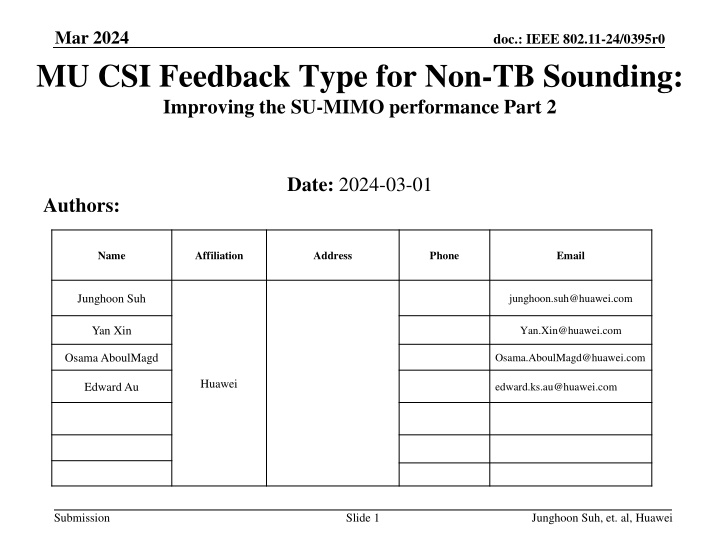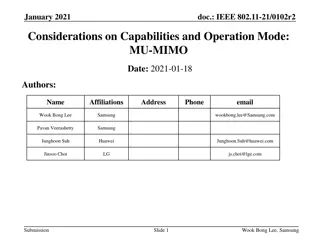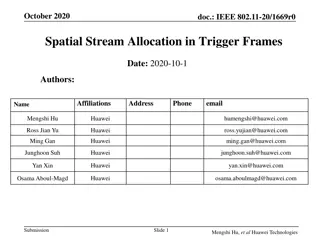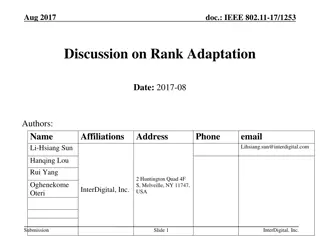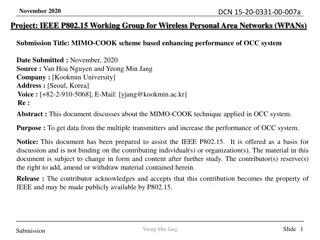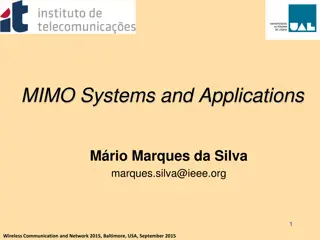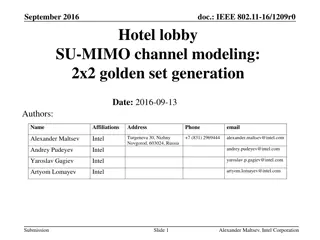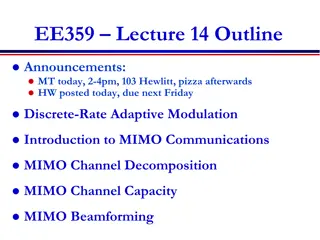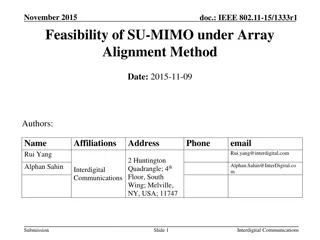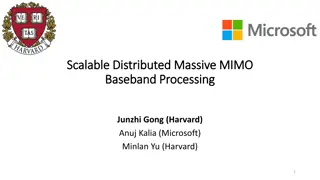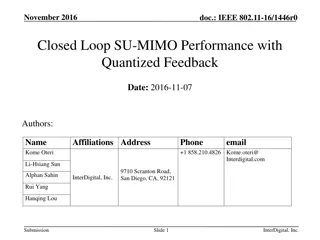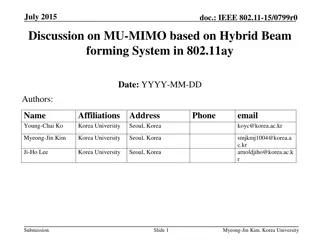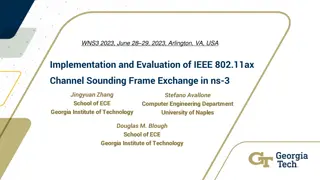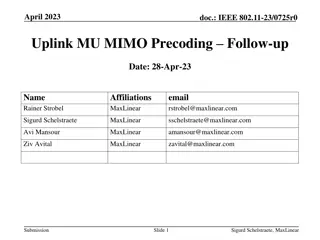Improving SU-MIMO Performance in IEEE 802.11
This document delves into enhancing SU-MIMO performance with a focus on non-TB sounding, providing valuable insights on advancements in CSI feedback for IEEE 802.11 systems. Part 2 of the series explores strategies to elevate connectivity and throughput efficiency.
Download Presentation

Please find below an Image/Link to download the presentation.
The content on the website is provided AS IS for your information and personal use only. It may not be sold, licensed, or shared on other websites without obtaining consent from the author.If you encounter any issues during the download, it is possible that the publisher has removed the file from their server.
You are allowed to download the files provided on this website for personal or commercial use, subject to the condition that they are used lawfully. All files are the property of their respective owners.
The content on the website is provided AS IS for your information and personal use only. It may not be sold, licensed, or shared on other websites without obtaining consent from the author.
E N D
Presentation Transcript
Mar 2024 MU CSI Feedback Type for Non-TB Sounding: Improving the SU-MIMO performance Part 2 doc.: IEEE 802.11-24/0395r0 Date: 2024-03-01 Authors: Name Affiliation Address Phone Email Junghoon Suh junghoon.suh@huawei.com Yan Xin Yan.Xin@huawei.com Osama AboulMagd Osama.AboulMagd@huawei.com Huawei Edward Au edward.ks.au@huawei.com Submission Slide 1 Junghoon Suh, et. al, Huawei
Mar 2024 doc.: IEEE 802.11-24/0395r0 Background - The SU transmission is a common use case in WLAN - Several proposals have been proposed to improve the link throughput and the quality between a single AP and a single STA [1-5] - Most proposals above require an accurate singular value feedback - Average SNR feedback per stream is not being practically used among the currently deployed APs regardless of its support in the 802.11 Specification - MU type of CSI Feedback may be required to further improve the SU- MIMO performance - We can allow more options in choosing the number of LTFs Submission Slide 2 Junghoon Suh, et. al, Huawei
Mar 2024 doc.: IEEE 802.11-24/0395r0 Background A water-filling algorithm which assigns more TX power to the stream with higher singular value feedback is well-known to achieve an optimum performance Few 11bn contributions have shown the performance results based on a water-filling algorithm [3] shows the little performance gain for an Eigen-Beamforming (SVD Beamforming: Eigen vectors being used for a precoder) with a power scaling (reverse water-filling: higher TX power being allocated to the stream with the lower singular value) against the pure Eigen-Beamforming (EGBF) with an equal modulation across the streams It is an unsuitable combination between an EGBF and a reverse water- filling, because an EGBF inherently assigns more TX power to the stronger stream but the reverse water-filling actually reverse it Submission Slide 3 Junghoon Suh, et. al, Huawei
Mar 2024 doc.: IEEE 802.11-24/0395r0 ZFBF: a natural reverse water-filling Eigen Beamforming (EGBF) Channel (?) is given as ? = ? ?? and ? (Right Singular Matrix) here is fed back to the Beamformer in case of the SU CSI Feedback (FB) type This right singular matrix ? can be used for a beam steering matrix in the beamformer side Eigen beamforming The average SNR (averaged eigen value per RX stream) can be used for a waterfilling algorithm of TX power per stream together with applying the different modulation to each TX stream This feature is not available in the current main stream 802.11 Zero Forcing Beamforming (ZF-BF or MMSE-BF however you may want to call it) It requires the MU CSI FB type where the Eigen value of the channel per subcarrier (actually per Ng-subcarriers) and per RX stream are fed back to the beamformer along with the right singular matrix, ? Since and ? are fed back from the beamformee to the beamformer, we can reconstruct the DL channel at the beamformer side, ?= ?? ?? ? ??+ ?-1 is the ZF-BF based BF Steering matrix ? is a ??? diagonal matrix and each diagonal element is the SNR measured at each RX RF chain of the Beamformee. ? is the number of RX RF chain at the beamformee. This scheme is a kind of reverse-waterfilling scheme without allocating the different TX power per stream Submission Slide 4 Junghoon Suh, et. al, Huawei
Mar 2024 doc.: IEEE 802.11-24/0395r0 CSI FB type for Non-TB Sounding in HE and EHT For Non-TB Sounding of HE and EHT, there are only two CSI feedback types available, which are SU and CQI CQI feedback is computed by averaging the Eigen values of channel over an indicated frequency range for the OFDMA scheduling purpose The SU type is basically the feedback of the right singular matrix of the channel along with the average SNR values of the channel per stream Submission Slide 5 Junghoon Suh, et. al, Huawei
Mar 2024 doc.: IEEE 802.11-24/0395r0 CSI FB Type in the UHR Non-TB Sounding MU CSI FB is necessary regardless of TB or Non-TB Sounding We need to include the MU CSI FB type in an NDPA of any Non-TB Sounding period In the Table 9-45 of the EHT Specification, 802.11be D2.3, we can set the B26 to 1 to indicate the MU CSI FB Type with the B25 set to 0 Submission Slide 6 Junghoon Suh, et. al, Huawei
Mar 2024 doc.: IEEE 802.11-24/0395r0 More options in the LTF Extension In the current EHT Common field of EHT-SIG field, there are 3 bits assigned to indicate the Number of EHT-LTFs It is only allowed to use twice as many LTFs as the number of TX Spatial Streams (SS), that is, for 1, 2, and 4 SS, it is only allowed to use 2, 4, and 8 LTFs for LTF extension We propose to allow as many LTFs as the integer multiples of TX SS with 8 LTFs as being the maximum E.g. for 2 TX SS, we can allow 2, 4, 6 and 8 LTFs The enhanced LTF Extension can be effective in the Range Extension Submission Slide 7 Junghoon Suh, et. al, Huawei
Mar 2024 doc.: IEEE 802.11-24/0395r0 Simulation setting ZFBF vs. EGBF SU-MIMO Chan_D, 2x2 MIMO (2 N_SS, 2 N_TX, 2 N_RX) 2, 4, or 8 N_LTF for data PPDU Chan_D, 2x4 MIMO (2 N_SS, 4 N_TX, 2 N_RX) 2, 4, or 8 N_LTF for data PPDU 4 N_LTF for a sounding PPDU 20 MHz, 4x-LTF Detection: MMSE Equal modulation across the streams RX-SNR where the effective channel gains are reflected in the calculation of SNR Submission Slide 8 Junghoon Suh, et. al, Huawei
Mar 2024 doc.: IEEE 802.11-24/0395r0 PER Performance of EGBF-SU 2X2 Submission Slide 9 Junghoon Suh, et. al, Huawei
Mar 2024 doc.: IEEE 802.11-24/0395r0 PER Performance of ZF-BF SU 2X2 Submission Slide 10 Junghoon Suh, et. al, Huawei
Mar 2024 doc.: IEEE 802.11-24/0395r0 PER Performance of ZF-BF SU 2X4 (Rank 2) Submission Slide 11 Junghoon Suh, et. al, Huawei
Mar 2024 doc.: IEEE 802.11-24/0395r0 Submission Slide 12 Junghoon Suh, et. al, Huawei
Mar 2024 doc.: IEEE 802.11-24/0395r0 Summary ZFBF based SU-MIMO shows about 7 dB gain over the EGBF (SVD-BF) based SU-MIMO with Equal Modulation across the streams MU CSI FB is necessary regardless of TB or Non-TB Sounding MU CSI FB type is useful for both ZFBF SU-MIMO and UEQM For UEQM, the MU CSI FB Type can be used for the determination of MCS or Modulation per stream We need to allow more options in choosing the number of LTFs Submission Slide 13 Junghoon Suh, et. al, Huawei
Mar 2024 doc.: IEEE 802.11-24/0395r0 References [1] 11-23/1927r1, Update of the Spatial Modulation, Junghoon Suh et.al., Huawei [2] 11-22/1930r0, Layered QoS and multi-layer transmission follow-up, Ross Jian Yu et.al., Huawei [3] 11-24/0016r0, UHR MIMO RvR enhancement with unequal modulation, Rui Cao et.al., NXP [4] 11-24/0113r0, Unequal Modulation in MIMO TxBF in 11bn, Alice Chen et.al., Qualcomm [5] 11-24/0117r0, Improved Tx Beamforming with UEQM, Ron Porat et.al., Broadcom Submission Slide 14 Junghoon Suh, et. al, Huawei
Mar 2024 doc.: IEEE 802.11-24/0395r0 SP 1 Do you agree to support the MU CSI FB Type in a Non-TB Sounding? Yes No Abs Submission Slide 15 Junghoon Suh, et. al, Huawei
Mar 2024 doc.: IEEE 802.11-24/0395r0 SP 2 Do you support to have more options in choosing the number of LTFs in proportion to the number of spatial streams? Yes No Abs Submission Slide 16 Junghoon Suh, et. al, Huawei
